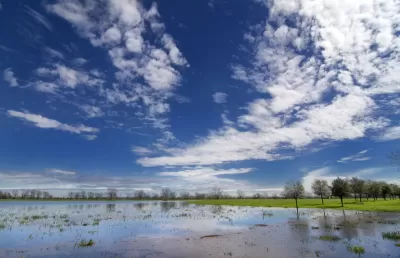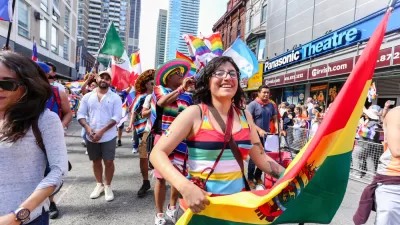The McHarg Center's "The 2100 Project: An Atlas for the Green New Deal" provides a series of maps an infographics to illustrate the way the United States uses land.

Iman Gosh shares a set of maps recently published by the McHarg Center that puts U.S. land use in perspective.
"The '2100 Project: An Atlas for the Green New Deal' provides a snapshot of U.S. land use (as of 2017), aimed at managing resources to support this future," explains Gosh. Here's how the maps break down the country's land use by type:
- Forests (27%)
- Shrubland (24%)
- Agriculture (17%)
- Grasslands and Pasture (17%)
- Wetlands (5%)
- Other (3%)
- Urban Areas (2%)
A few of Gosh's takeaways from the map include the outsized influence of urban areas, the vast footprint of forests, and some specifics about where the country grows its food.
"The U.S. population is set to grow by 100 million more people over the coming decades, raising the pressure on limited U.S. land and natural resources. This pressure will be felt everywhere, from dense urban land to agricultural farmland," concludes Gosh, with a message about the future of land use.
FULL STORY: Mapped: The Anatomy of Land Use in America

Planetizen Federal Action Tracker
A weekly monitor of how Trump’s orders and actions are impacting planners and planning in America.

Map: Where Senate Republicans Want to Sell Your Public Lands
For public land advocates, the Senate Republicans’ proposal to sell millions of acres of public land in the West is “the biggest fight of their careers.”

Restaurant Patios Were a Pandemic Win — Why Were They so Hard to Keep?
Social distancing requirements and changes in travel patterns prompted cities to pilot new uses for street and sidewalk space. Then it got complicated.

Albuquerque Route 66 Motels Become Affordable Housing
A $4 million city fund is incentivizing developers to breathe new life into derelict midcentury motels.

DC Area County Eliminates Bus Fares
Montgomery County joins a growing trend of making transit free.

Platform Pilsner: Vancouver Transit Agency Releases... a Beer?
TransLink will receive a portion of every sale of the four-pack.
Urban Design for Planners 1: Software Tools
This six-course series explores essential urban design concepts using open source software and equips planners with the tools they need to participate fully in the urban design process.
Planning for Universal Design
Learn the tools for implementing Universal Design in planning regulations.
Heyer Gruel & Associates PA
JM Goldson LLC
Custer County Colorado
City of Camden Redevelopment Agency
City of Astoria
Transportation Research & Education Center (TREC) at Portland State University
Camden Redevelopment Agency
City of Claremont
Municipality of Princeton (NJ)





























